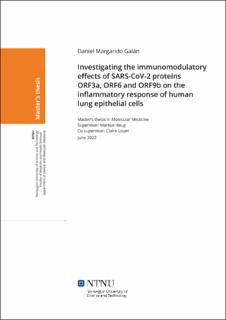| dc.description.abstract | The COVID-19 pandemic has taken an unprecedented number of lives and brought incredibly high social costs across the globe. The disease severity is associated with a strong innate immune dysregulation characterised by low or inexistent levels of type I and type III IFNs early in disease as well as an overall heightened inflammatory response. Several proteins of SARS-CoV-2, the causative agents of COVID-19 have been identified as important contributors to the immunopathology. These viral proteins may interfere with innate immune functions of the host cell and thus enable immune evasion of the virus. Most of the research on immune evasion of SARS-CoV-2 has been centred on type I IFN rather than type III IFN responses, which are the family of IFNs that are mainly produced by lung epithelial cells, the main target and replication site of SARS-CoV-2. Moreover, these studies have been mostly performed on cell models that are not as relevant in the context of SARS-CoV-2 infection. In this project, we focused on studying the effects of SARS-CoV-2 proteins on the production of type III IFNs and other inflammatory cytokines in lung epithelial cells. A549 human lung epithelial cells transduced with plasmids for the SARS-CoV-2 proteins ORF3a, ORF6 and ORF9b under a doxycycline-inducible promotor were used for this study. We analysed the production of type III IFNs, pro-inflammatory cytokine IL-6 and chemokine IL-8 after stimulation of the RIG-I/MDA5 signalling pathway by poly(I:C) treatment. We found IL-6 to be upregulated at the mRNA transcript level in cells expressing SARS-CoV-2 proteins. This suggests a possible role of these SARS-CoV-2 proteins in the enhancement of the inflammatory response in the organism that is linked to complications in the patients’ outcome. However, ORF3a, ORF6 and ORF9b induced no significant changes in the production of type III IFNs, IL-6 and IL-8 at the protein level. As of today, the precise functions of these and other SARS-CoV-2 proteins are yet to be completely unveiled. Our study indicates that ORF3a, ORF6 and ORF9 do not significantly alter the outcome of stimulation of the RIG-I/MDA5 pathway in human epithelial cells. Further studies on virus-host interactions with other SARS-CoV-2 proteins or in other model systems might deepen our knowledge on the immunomodulatory functions of SARS-CoV-2 proteins and contribute to develop therapeutical tools for the treatment of COVID-19 and other similar outbreaks that could arise in the future. | |
